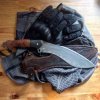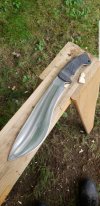I have a very old Gurka Kukri that I got somewhere when I was a kid - probably 25-30 years ago at least. I can post a picture later but it is the Kukri design (near as I can tell - the general shape is a Kukri anyway) and is about 12" long. The handle is wood and riveted to the blade along with a "pommel plate" we'll call it.
The sheath is a wooden sheath with a thin leather covering that also holds two accessory knives. These look like they were made by a 5 year old and IIRC at least one has the handle about to come off. The sheath also has a metal device at the tip, and it slips into a belt loop that is a separate piece (and falls off a lot). I've considered making a Kydex sheath for it if I determine it is worth it.
I know Kukris are kind of a hand-made thing and there is no real standard for them. That said, this thing is a beast of a knife. The blade is probably 1/4" thick at it's thickest point.
I have a few questions about the design in general:
1) Is there a standard Kukri design? I took a peek on Amazon and there are several different vendors and all look like they are handmade in a hut somewhere. I know truck leaf springs are a desired material for the blades (could do worse) but from there.......
2) Does anyone make a modern equivalent of this thing, using more modern materials and more consistent manufacturing techniques? I've seen a few but I don't know if they are any good. I think Gerber and Smith and Wesson have versions out there. Are they better than the originals?
3) What is the general consensus of the design? I know the Gurkhas are some fierce fighters but how useful are they in general field/camping use? It looks like it would make a hell of a light-duty ax and small critter (including the 2-legged kind) repellant.
Any info would be appreciated. I'll see if I can post a picture later.
Thanks,
The sheath is a wooden sheath with a thin leather covering that also holds two accessory knives. These look like they were made by a 5 year old and IIRC at least one has the handle about to come off. The sheath also has a metal device at the tip, and it slips into a belt loop that is a separate piece (and falls off a lot). I've considered making a Kydex sheath for it if I determine it is worth it.
I know Kukris are kind of a hand-made thing and there is no real standard for them. That said, this thing is a beast of a knife. The blade is probably 1/4" thick at it's thickest point.
I have a few questions about the design in general:
1) Is there a standard Kukri design? I took a peek on Amazon and there are several different vendors and all look like they are handmade in a hut somewhere. I know truck leaf springs are a desired material for the blades (could do worse) but from there.......
2) Does anyone make a modern equivalent of this thing, using more modern materials and more consistent manufacturing techniques? I've seen a few but I don't know if they are any good. I think Gerber and Smith and Wesson have versions out there. Are they better than the originals?
3) What is the general consensus of the design? I know the Gurkhas are some fierce fighters but how useful are they in general field/camping use? It looks like it would make a hell of a light-duty ax and small critter (including the 2-legged kind) repellant.
Any info would be appreciated. I'll see if I can post a picture later.
Thanks,






